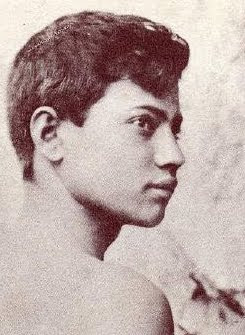"Taormina, le 12 avril 1903,
Cher André,
Enfin arrivé, long voyage, mais Taormina est un éblouissement. Tout est en fleurs, pas seulement les amandiers, l'Etna fume au loin, vue sublime depuis le teatro greco. Hotel San Domenico parfait, carrefour des élégances. Ai rencontré cet artiste allemand dont nous avons tant parlé. Il expose ses oeuvres Corso Umberto: rêves, idées, peintures ou photographies ? Un peu tout cela à la fois. Tu vois la façade de sa boutique sur ma carte, imagine la plus charmante des vitrines. Je songe à oublier Paris et à me transformer en pâtre grec, vivant d'olives, de soleil et d'amour, avec Marco mio et mes meilleures éditions de Virgile...
Tityre, tu patulae recubans sub tegmine fagi
siluestrem tenui musam meditaris aunea....*
Tibi, as always
Henri"
* "Tityre, couché sous l'abri d'un hêtre touffu, tu étudies un air champêtre sur tes minces pipeaux" Virgile, Bucolique, 1, v. 1. (note de l'éditeur).
(Von Gloeden Archive, Lettre d'Henri à André, 1903 (référence: 1903/04/5).
------
Taormina, April 12, 1903
Dear André,
Such a long journey, but at least, I am in Taormina: it is a dazzling sight ! Everything is blossoming, and not only almond trees. Smoke from Etna can be seen from a distance, the teatro greco offers a sublime view. San Domenico Hotel is perfect, so many elegant people meet there. I met this German artist we spoke so much about. There is an exhibition of his work Corso Umberto: dreams, ideas, paintings or photographs ? You can see the front of his shop on my postcard, feel free to imagine the most charming shop window. I am seriously thinking about leaving Paris forever and living as a Greek shepherd. I would survive with a few olives, with sun and with a lot of love, with Marco mio and my best editions of Vergil...
Tityre, tu patulae recubans sub tegmine fagi
siluestrem tenui musam meditaris auena...*
Tibi, comme toujours
Henri"
* Please, learn Latin or French language. The quote is from Vergil, Bucolics, I, 1 (note by the editor).
(Von Gloeden Archive, Lettre d'Henri à André, 1903 (call number: 1903/04/5).



























